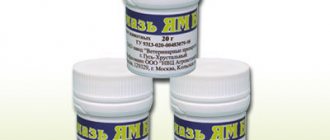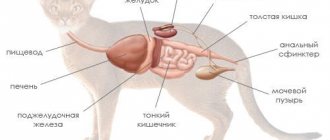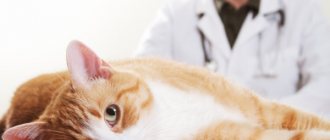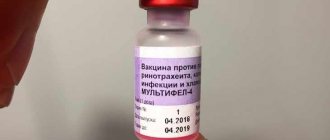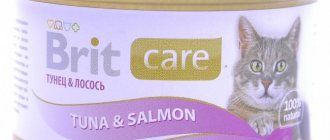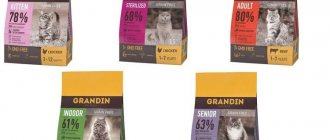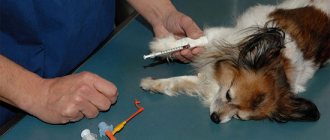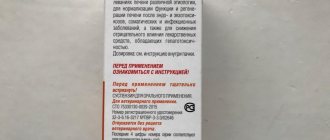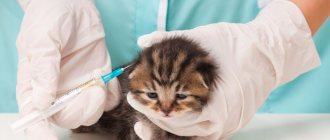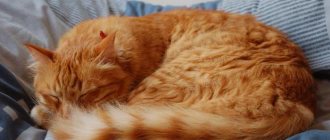3876Pavel
Feline hepatic lipidosis is a large amount of accumulated fat in the liver. It is a popular and dangerous liver disease in felines. Liver lipidosis in cats becomes noticeable when an excessive amount of triglycerides accumulates in hepatocytes in an amount of more than half. This can lead to interruptions in liver function and severe cholestasis.
The disease lipidosis occurs due to severe or constant starvation of cats. Without treatment, developing metabolic dysregulation often occurs, and subsequently death. The liver is considered the most important organ in the body and performs a large number of different functions, including metabolism, emulsification of fats and breakdown of red blood cells. Due to this, a malfunction of the liver, which occurs when lipids accumulate, can cause death in cats due to liver failure.
© shutterstock
There are two types of lipidosis::
- primary – this type appears in cats with obesity or anorexia. Without proper treatment, lipidosis is fatal.
- secondary – this type of disease appears as a complication after other diseases. Therefore, the cat needs intensive immediate treatment for lipidosis, along with the underlying disease.
The risk group includes cats and mature cats living in houses. Cats living with humans are predisposed to becoming overweight due to a sedentary life and due to improper feeding. Cats are carnivorous animals, members of the cat family. In the wild, they can hunt and lead an active life, and due to this, reduce the accumulation of excess fat throughout the body to zero. The owner needs to closely monitor the pet so as not to miss the symptoms of liver lipidosis in cats.
The cat's body is not able to convert a large amount of accumulated fat deposits, because of this, the fat that appears in the liver is poorly processed. This creates the prerequisites for changes in lipid metabolism, the accumulation of fat in the liver and the formation of its dysfunction, and as a result, liver lipidosis syndrome may appear in cats.
© shutterstock
What is lipidosis
Any cat that is overweight is at risk. Owners of animals who are stressed due to a sudden change in food or who have some other illness should also be wary.
The disease is characterized by the proliferation of adipose tissue in hepatocytes. Due to the degeneration of organ cells into fatty liver, it becomes like a piece of lard. If too many fatty acids are supplied, the organ cells cannot cope with their processing.
Many veterinarians have recently associated the appearance of the disease with hyperthyroidism, pathologies of the heart, kidneys, diabetes and other factors. But in less than half of the cases, tailed patients are diagnosed with “idiopathic lipidosis”, since the doctor cannot determine the cause of the disease.
Two independent forms of pathology are known:
- Primary can manifest itself in an overweight or anorexic animal. If the disease is not diagnosed in time and assistance is not provided, the pet will die.
- Secondary always appears against the background of an underlying disease - diabetes, pancreatitis, heart disease, or others. A specialist has to treat both diseases.
Treatment of the disease
Treatment of lipidosis in the early stages is possible at home. If the disease progresses, treatment should be carried out in a hospital under the supervision of a doctor. The complex of therapeutic measures includes:
- Proper feeding. A balanced diet for cats with lipidosis is the key to a quick recovery. Owners must provide their pets with properly selected industrial food. If the cat cannot eat on its own or the body rejects food, feeding is carried out through feeding tubes or an IV. Meals should be fractional, it is advisable that the intervals between meals be 3-4 hours. Initially, the pet is offered a small amount of food, gradually bringing it up to normal.
- Elimination of signs of intoxication. To eliminate intoxication and dehydration of the body, veterinarians recommend giving animals IVs or subcutaneous injections. In this case, special solutions should be used.
- Taking medications. Depending on the degree of the disease, the doctor prescribes antibiotic drugs, multivitamin complexes, immunomodulators, choleretic or antiemetics, etc.
Treatment can last from 2 to 6 weeks, the recovery period takes several months. At this time, it is necessary to protect the animal from stressful situations, provide it with a regular balanced diet and monitor the general condition of the pet. If concomitant pathologies occur, you should seek advice from a specialist and take measures to eliminate them.
Causes
The disease can occur in acute or chronic form. As a primary disease, it occurs due to feeding cats spoiled homemade food or expired dry food, taking a number of medications, and ingesting poisons - mineral fertilizers, nitrates, etc.
Fatty degeneration can be concomitant with other systemic diseases, which are characterized by hormonal imbalance and metabolism. These include hepatitis, diabetes mellitus, cachexia, that is, refusal to feed or starvation, as well as obesity caused by overfeeding.
Of all the above reasons, the most dangerous are obesity or prolonged starvation of the pet.
What is liver lipidosis and what causes it in dogs?
Fatty degeneration or lipidosis develops in the liver structures with a pronounced disruption of metabolic processes between fats and proteins. There are several types of lipidosis - idiopathic (primary) and developing against the background of another disease in the body (secondary).
Primary lipidosis in dogs of the idiopathic type develops with severe obesity. It is most often diagnosed in dogs kept in apartment conditions and without free access to the street. As a result of the accumulation of a large number of lipid components in the cellular structures of the liver, a change in the morphological plan occurs and acute hepatopathy develops.
The secondary type of pathology develops against the background of disorders in the endocrine and nervous systems. Factors that provoke the occurrence of secondary liver lipidosis are inflammatory processes in the pancreas and intestinal pathologies. Fatty degeneration of the secondary type does not occur as a result of obesity.
Liver lipidosis develops against the background of an acute deficiency of specific lipotropic substances. This is due to exocrine insufficiency of pancreatic enzymes produced by the pancreas.
Lipidosis is often combined with pathologies of the biliary system (gallbladder and bile ducts). Fatty degeneration occurs with gallstone disease. Also factors that provoke the development of lipidosis in dogs are:
- severe overfeeding of the animal. In this regard, an excessive amount of fat enters the body along with food. Fatty degeneration develops especially often with natural feeding.
- dry food contains low-quality ingredients, as well as nitrates and nitrites.
- insufficiency of protein metabolism. The accumulation of lipid particles in the liver provokes disturbances in the trophism of lipids and proteins to the tissue structures of the liver.
- intoxication of the body with chemicals that have a pronounced pathogenic effect on liver cells.
- long-term use of certain medications that have hepatotoxic effects.
Find out the opinion of veterinarians about the norm of dog food>>>
Fat deposition in the liver also has its own characteristics. It can be large-droplet or small-droplet. As a result of the type of deposit, the type of pathology is formed - acute or chronic.
Signs
Due to the accumulation of fat in cells in the animal’s body, toxic metabolic products accumulate, as a result of which digestive function, bile formation are disrupted, and metabolism also occurs incorrectly.
Characteristic signs of the disease are:
- refusal to eat for 3 or more days;
- weight loss;
- dehydration;
- severe drooling;
- yellowing of the skin, mucous membranes and sclera of the eyes.
The animal begins to vomit, diarrhea or constipation appears. The liver increases in size, but the animal does not experience discomfort when palpated. There are also nervous symptoms in the form of numbness, convulsions, loss of strength and depression.
Any symptom is dangerous to the animal’s health and should be shown to a veterinarian as soon as possible. In half of the animals, in addition to the indicated signs, coagulopathy develops, that is, a blood clotting disorder, and spontaneous bleeding may occur.
Liver lipidosis in cats
Content
- Clinical signs
- Diagnostics
- Treatment
Lipidosis or fatty liver is a common liver disease in cats associated with the accumulation of fat in liver cells. Lipidosis occurs more often in obese cats leading a sedentary lifestyle. This disease can be fatal.
Clinical signs
In most cases, lipidosis occurs in cats that stop eating for some reason. In such cases, the body begins to use fat reserves to replace energy, while the fat enters the liver to be converted into lipoproteins. The increased intake of fat exceeds the liver's ability to transform it for energy, and fat then accumulates in liver cells. The reasons for lack of appetite can be different, for example, stress due to a sudden change in food, the appearance of new animals in the house, or if the cat cannot find food for a long time. Various systemic diseases can cause loss of appetite, such as deterioration of kidney function. With liver lipidosis, many metabolic disorders occur associated with deterioration of liver function; the level of taurine, vitamin K1 (which can lead to coagulopathies), B vitamins and electrolytes, especially potassium and phosphorus, decreases in the blood plasma.
Clinical signs vary but are usually as follows:
- sharp weight loss: more than 25%,
- dehydration,
- lethargy,
- vomit,
- salivation,
- pallor of mucous membranes,
- ventroflexion (forced position of the head, inability to raise it)
- jaundice,
- constipation/diarrhea.
Diarrhea may be present in cats with underlying medical conditions such as lymphoma or inflammatory bowel disease.
Diagnostics
A clinical blood test revealed non-regenerative anemia, the appearance of Heinz bodies, and a change in the number of leukocytes. A bleeding disorder may be present.
In biochemical analysis, increased ALT, AST, alkaline phosphatase. Less specific are increases in GGT, gopoalbuminemia, and hyperglobulinemia.
Ultrasound shows a change in the echogenicity of the liver parenchyma, hepatomegaly.
The diagnosis is made based on medical history, examination, laboratory tests, ultrasound data, and aspiration cytology. Liver biopsy is not the main diagnostic method, but it may be required for differential diagnosis if the underlying disease is cholangitis, cholangiohepatitis or hepatic lymphoma.
Treatment
Treatment of hepatic lipidosis in cats is aimed at restoring dehydration, electrolyte and metabolic disturbances. Providing the cat with food plays an important role: if she does not eat on her own, then she has to be force-fed. You can feed from a Spitz, pouring food into the mouth in small portions, or use special tubes through which food will flow into the stomach: a nasogastric tube, esophagostomy or gastrostomy tube. Feeding tubes are often easier to use and more effective since the cat cannot spit out the food. Use highly nutritious wet food.
On the first day, 1/3 - 1/2 of the total dose of feed is administered, then gradually increase it over 2-4 days. When the cat begins to eat on its own, the feeding tubes are removed. Full recovery usually takes 3-6 weeks.
Prevention of lipidosis is regular balanced feeding and maintaining the cat in normal condition.
The article was prepared by doctors of the therapeutic department "MEDVET" © 2021 SEC "MEDVET"
How to identify
In laboratory conditions, the diagnosis of the disease is based on a general blood test, which shows the appearance of red blood cells of abnormal shape and size, the destruction of red blood cells, as well as the biochemical composition. There is a decrease in glucose levels, an increase in bilirubin and cholesterol, liver enzymes and alkaline phosphatase, and electrolyte imbalance, that is, low levels of magnesium, phosphorus and potassium.
The veterinarian will definitely order a urine test, which will show a high concentration of bilirubin. The main method of confirming the diagnosis is ultrasound examination (US). An ultrasound of the entire abdominal cavity is performed to detect concomitant diseases. To visualize the affected organ, it is also important to perform radiography. To clarify the diagnosis, a biopsy is also performed.
Etiopathogenesis
There are exogenous and hereditary factors in the development of hepatosis. Exogenous include toxic effects (acute and chronic), pathology of other organs and systems and nutritional (nutritional) factors - thyroid diseases, diabetes mellitus, obesity, Cushing's syndrome, protein deficiency, vitamin deficiencies, etc. Pigmentary hepatosis is caused by disturbances in the metabolism of bilirubin and bile acids in the liver.
Fatty hepatosis
Steatohepatosis is a liver disease accompanied by fatty liver cells. The causes of obesity in liver cells are most often an excessive intake of fats and carbohydrates in food or their excessive accumulation in the blood, due to various metabolic disorders, metabolic syndrome, endocrine diseases, exposure to substances toxic to the liver, including alcohol and hepatotoxic drugs.
It is possible to develop fatty hepatosis due to impaired excretion of fat from the liver. This occurs when the amount of substances involved in fat processing (protein, lipotropic factors) decreases. The formation of phospholipids, beta-lipoproteins, and lecithin from fats is disrupted, as a result of which “extra” free fats are deposited in the liver cells.
| This section is not completed. You will help the project by correcting and expanding it. |
Treatment
Effective treatment is based on taking medications and creating the right diet for the sick pet. Veterinarians prescribe the following medications:
- Antibiotics are used only if the inflammatory or infectious etiology of the disease is confirmed.
- To restore water and electrolyte balance, fluid therapy is used; cats are given intravenous solutions for several days, then they are replaced with subcutaneous injections. Do not use solutions containing lactic acid salts or dextrose. The most commonly prescribed is isotonic glucose and Ringer's solution.
- Ondansetron and Cerucal in injection form have proven themselves well as antiemetics.
- Among hepatoprotectors and choleretic drugs, Ursofalk and Essentiale Forte are prescribed. The latter is not considered particularly effective.
- Sick cats need water-soluble B vitamins - such as Hemobalance, injections of cyanocobalamin as a source of vitamin B12, vitamin K for increased bleeding, Dibikor with taurine, as well as L-carnitine.
For this disease, it is recommended to feed your pet with special industrial food. Equally important is to follow a diet with a high level of protein - up to 45%. If the animal categorically refuses food, a nasogastric, esophagostomy or gastrostomy tube is installed. Warmed liquid food is supplied through one of these devices. Feeding is done every 4 hours. The device is first checked by introducing warm water. Sometimes it takes up to a month and a half to force-feed a sick cat.
What happens to a cat with lipidosis?
What's the prognosis? He is considered dubious. The fact is that even with intensive care, about 35% of sick animals die. In other situations, cats usually recover, but the recovery period is very long (more than two months). Sometimes the animal has to be kept on parenteral nutrition for a long time. As a rule, liver damage is still reversible.
Competent disease prevention plays an important role. The simplest technique is to prevent the animal from becoming obese. Feed your pet a balanced diet, provide it with vitamins, and monitor the quality of food. If a cat has developed obesity, then it should be considered a “candidate” for developing lipidosis. Such an animal must be regularly examined and tested in a well-equipped veterinary clinic. Of course, every effort should be made to “burn” excess fat.
Forecast
Experts consider this liver disease to be very dangerous, in which it is impossible to predict a complete recovery. For every third cat it ends in death. But if the pathology was identified in a timely manner and therapy was started, the sick animal gets a chance to live a long and happy life. The effectiveness of therapeutic measures depends on prompt diagnosis, the condition of the tailed patient, his age, as well as the animal owner’s compliance with the veterinarian’s recommendations.
Kittens and young cats have a better chance of maximizing recovery than obese older animals, who often already have aggravating concomitant illnesses.
Treatment of the disease
To help burn fat better, your pet can be prescribed L-Carnitine.
Methods of influencing lipidosis depend on the causes, severity of the disease, associated disorders and the duration of the cat’s refusal to eat. Therapy is carried out in a hospital setting or on an outpatient basis. The main medicines are presented in the table:
| Drugs | Therapeutic effect | Name |
| Rehydrants | Removes toxic substances | "Ringera Lactate" |
| Replenish loss of fluid and nutrients | ||
| Antiemetics | Eliminate nausea and vomiting | "Cerucal" |
| Coagulants | Improve blood clotting | "Thrombin" |
| Lipolitics | Stimulates metabolism and fat burning | "L-carnitine" |
| Antisecretory | Restore the functioning of the gastrointestinal tract | "Tagamet" |
| Metabolics | Improve energy exchange and tissue nutrition | "Dibikor" |
| Antibacterial | Suppress pathogenic microflora | "Neomycin" |
| Vitamins | Replenishes the lack of nutrients | "Hemobalance" |
| Increases immunity and stamina | "Cyancobalamin" |
Symptoms of lipidosis
Liver lipidosis in dogs in the vast majority of clinical cases in veterinary medicine is combined with other serious pathologies that occur in the animal’s body. Diseases of the endocrine system that affect metabolic disorders, such as diabetes mellitus and systemic intoxications, provoke changes in the functional characteristics of the liver.
This is due to the fact that the liver structures, and the entire organ as a whole, are the body’s natural filter and all harmful substances pass through them.
In addition to internal pathologies, the development of lipidosis is caused by infectious diseases. The acute form of lipidosis develops rapidly. There are signs of general intoxication of the body, as well as yellowness of the visible mucous membranes. The dog becomes depressed, refuses active games, looks weak and apathetic. Sometimes there is an increase in body temperature to subfebrile values, and refusal to feed.
The organ itself in the acute stage of pathology increases in volume. Against the background of changes in the functional characteristics of the liver, the filtering capacity decreases. Bile acids, amines, phenols and ammonia begin to accumulate in the dog’s body, which ultimately leads to the development of hepatic coma.
As the pathological process progresses, the pet experiences nausea and eruption of gastric contents. Muscle tone decreases, convulsive phenomena cannot be excluded.
Attention! The acute form of liver lipidosis is dangerous due to the rapid development and onset of hepatic coma, after which the death of the pet occurs.
The chronic form of fatty degeneration develops much more slowly. The animal looks depressed, partially refuses to eat, the dog’s overall activity decreases, and constipation is observed. Body temperature remains the same, and visible mucous membranes are rarely characterized by icterus (yellowness). The disease can occur with an erased clinical picture, slowly progressing, gradually poisoning the body with metabolic products.
Prevention
Any disease is easier to prevent than to cure. The best prevention of fatty hepatosis is proper feeding:
- The diet should not be too high in calories, but the cat needs a large amount of complete protein.
- Feeding expired products or cheap dry food is unacceptable.
- The pet is protected from accidental poisoning (hide medications, household chemicals).
The second most important point is timely contacting a veterinary clinic for any diseases. It doesn’t matter for what reason a cat refuses to eat, sometimes it’s a simple runny nose or a high temperature due to an abscess of the paraanal gland. The main thing is that hunger should not last more than 2 days, it is necessary to resort to force feeding and eliminate the cause of anorexia as quickly as possible.
Prevention of lipidosis
Liver lipidosis, especially in dogs, is a serious pathology. Without timely treatment, the pet may die. In order to prevent the development of a pathological process, it is necessary to regularly monitor the functioning of internal organs.
It is recommended to carry out ultrasound diagnostics at least once a year. In order to prevent metabolic disorders leading to liver damage, overfeeding the animal should not be allowed.
Food selected for your pet must be of high quality, balanced in all nutrients. If there are any changes in your pet’s health, you should not self-medicate. It is important to consult a veterinarian for advice.
Do you want to know more about the article or something? Call +79774692712, we will advise you.
Symptoms
What symptoms can you see of liver lipidosis in cats? Many cats with this disease have a pronounced sickly appearance, they seem to be “aging”, their skin and coat condition sharply worsens, they are lethargic and apathetic. Sick animals lose their appetite, and progressive exhaustion develops. Alas, all these signs develop very slowly, so many cats end up at the vet in the state of a living skeleton.
Attention! This is especially scary in the case of long-haired breeds: due to the lush fur, exhaustion is not so noticeable, but when palpating it is easy to detect protruding ribs, each vertebra is clearly felt. There are often cases of sporadic vomiting, and jaundice gradually develops.
